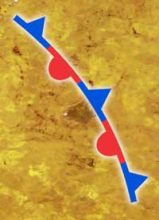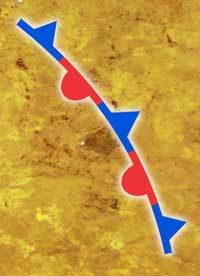

Warm fronts also are common, especially from Fall through Spring when larger temperature differences exist across the United States. Sometimes, fronts aloft (above the surface) can result in precipitation ahead of cold fronts. This is a simplified view of a cold front. If the air also is unstable, thunderstorms can develop as well. If the air contains enough moisture, rain can occur. Where the two air masses meet, convergence often occurs which can result in upward motion of air parcels. This vertical cross-section of a cold front shows cold air behind the cold front (dark blue lines) advancing into warmer air ahead of the front. With a cold front, cold air advances and displaces the warm air since cold air is more dense (heavier) than warm air. Air normally is warmer ahead of a cold front and colder behind it.

Here, a cold front is shown which can be present any time of the year, but is most pronounced and noticeable during the winter. A front represents a boundary between two air masses that contain different temperature, wind, and moisture properties. Surface low pressure systems usually have fronts associated with them. Each reporting station's observation gives wind direction and speed, temperature, dewpoint, and pressure at that station. Here, a typical surface weather map shows winds rotating counterclockwise around a low pressure system. Surface winds generally flow at an angle to the isobars from high to low pressure. Lines of equal pressure between highs and lows are called " isobars ".

The actual pressure of these systems can be measured in either inches of mercury (e.g., 30.10) or millibars (e.g., 1004 mb). At the surface, winds flow counterclockwise (cyclonically) around low pressure, and clockwise (anticyclonically) around high pressure. This picture shows an example of a high and low pressure system.


 0 kommentar(er)
0 kommentar(er)
